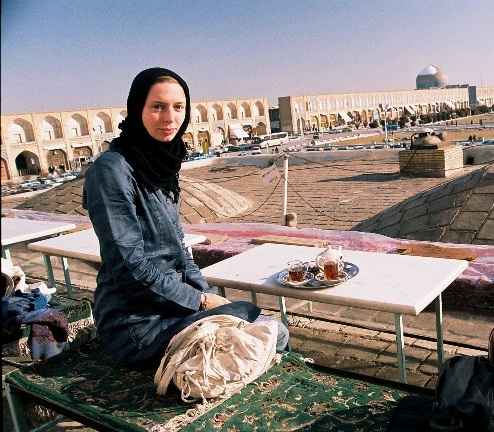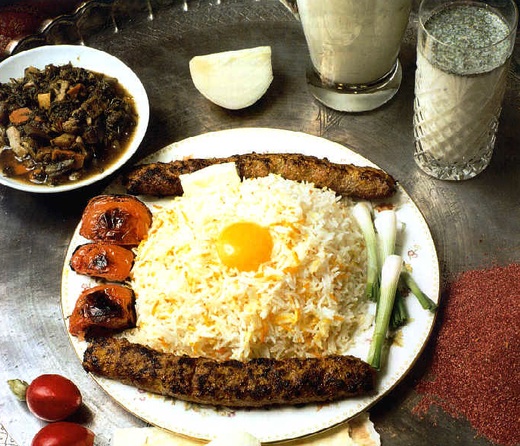(http://islandbreath.blogspot.com/2009/06/roof-revolution-in-iran.html)
 Image above: A young Iranian women in chador about to have chai (tea) on bazaar roof in Isfahan. From (http://dodihi.bloog.pl/kat,193696,index.html)
Image above: A young Iranian women in chador about to have chai (tea) on bazaar roof in Isfahan. From (http://dodihi.bloog.pl/kat,193696,index.html)

"The revolution will not be televised... it will be blogged & twittered."
I lived in Iran for over a year between July of 1975 and September of 1976. When I arrived at Teheran Airport from New York City I had no visa and I was carrying about one-hundred audio-cassette tapes I had made to entertain myself. I was immediately separated from my tapes and taken away by security police.
It seems you were supposed to tell people ahead of time you were coming before entering their country. It never dawned on me. I had only been to Canada and Mexico, and back then crossing country borders in North America was as easy as going from Manhattan to Hoboken, New Jersey. Who knew?
The police finally let me go when they realized I was supposed to start work for a relative of the Shah the next day. I might not have had a visa but I had a job. The deal was that I was there to do planning and architectural work for Empress Fara Dibah's cousin, Kamran Diba. Kamran was the senior partner in DAZ Planning and Architecture.
The police did not, however, return my many homemade cassette music tapes. They said they had to listen to them first. It took three months of badgering to get them back. It turns out that in 1975 cassette tapes were the way ayatollah Khomeini brought the message of revolution to Iran from his exile in Paris. Tapes would arrive at a neighborhood mosque. Besides distributing tapes to other locations, a cleric would wait until night and then play the tape through the call-to-prayer public-address systems set up on the mosque roof. A high-tech presence for a medieval ayatollah.
The DAZ planning and architecture firm received all the work it could handle on planning towns and new cities throughout the country. I worked on everything from new gambling resorts on the Caspian to gated communities for Russian engineers in Isfahan.
I was there because, in 1975 after a year of OPEC oil crisis, the architectural firm I worked for in NYC, Davis Brody & Associates, needed a partnership in the middle-east to stay afloat. Big planning and engineering firms throughout the world were trying to get a foot in the door of any country that had oil money. Back then, if you were a firm with Jewish partners that meant Iran. The Shah was friendly.
Teheran is a dusty hot town in the summer. Most buildings were built side-by-side and flush with the street. Any yards, usually in the rear, were walled. Little breeze moved through the roses or stirred the fountains in the gardens, so most people retreated to the roof as the sun went down. There they could feel the cool air moving down into town from the valleys of the Alborz Moutnains. Snow might still be seen on their 12,000 foot peaks.

Image above: A typical dinner at a rooftop restaurant in Teheran. Roast lamb with rice (note raw egg) and a cold glass of yogurt drink. From(http://home.att.net/~aturpat/photo.htm).
Almost all buildings in Teheran had flat stucco roofs that were accessible from inside. Restaurants strung up Chinese lanterns and served platters of chelo kabob (lamb and rice) and glasses of maast (carbonated yogurt drink). Whole families would set up cots on Persian carpets and camp out on their roof and watch the stars twinkle.
I celebrated the 200th birthday of the United States watching a spectacular US military fireworks show from the roof of a friend's home in west Teheran after sunset. My friends and I sat in the cool of the night drinking beer wondering at the weirdness of it all. Weird because we Americans celebrated in a foreign country with booms and explosions (just good fun), but were a little shook up when we heard automatic gunfire in the middle of the night that never made the next day's paper.
It seems a revolution of some sort was going on amongst the Iranian people and we did not know much about it. The Shah had his hands full and did not want a lot of news about it getting around. Supposedly, while I was there, everything was just hunky-dorry, despite the occasional automatic gunfire at night.
This summer the nighttime roofs of Teheran are a place where a revolution is seething. People are chanting from the street "God is Great! Death to the dictator!" Not unlike the chants of thirty years ago. Then, like now, the inspiration is coming from the young, the idealistic, the educated, and the cosmopolitan. Women are now in the forefront of the action. But now the call to revolution is not coming from cassette-tapes in the mosques. Iranians are using the technology at hand. Cellphones, Twitter, Facebook, etc.
My experience with the young planners and architects at DAZ was that they rejected the Shah's effort to make Teheran look like a western European capital. They wanted a Persian expression of architecture and culture. Many were sympathetic to his ouster. I was not in Iran in 1979 for the fall of the Peacock Throne and disgraced exit of Shah Reza Palavi. What the idealists at DAZ got, when the Shah fell, was not what they were hoping for. Maybe this time the young Iranians will get it right.
.
1 comment :
Thanks for posting this personal account of your time in Tehran. I never heard the tape cassette story before.
Post a Comment